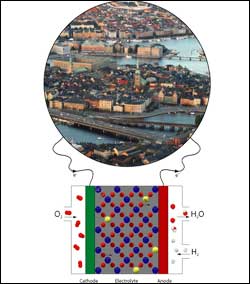Better fuel cells through quantum mechanics

In the future solid oxide fuel cells may supply residential areas like Stockholm with electricity. In a solid oxide fuel cell, chemically stored energy is converted to electricity with a high degree of efficiency. The figure illustrates this with the chemical reaction between oxygen and hydrogen, which yields water (plus electricity). The article by Andersson et al. explains how the electrolyte should be constructed for optimal performance.
Fuel cells must be made more efficient if they are to provide a viable alternative to traditional energy sources, and the choice of materials is crucial to how efficient they are. New findings from scientists at the Royal Institute of Technology (KTH) in Stockholm, Uppsala University, and Linköping University are opening new ways of finding optimal materials for better fuel cells much more quickly.
Using methods of calculation from quantum mechanics, the researchers managed to find a better way of understanding the connection between the atomic structure of an element and its capacity to conduct oxygen ions, which is key to the efficiency of fuel cells that use solid oxides as electrolyte materials (so-called solid oxide fuel cells).
The faster the transport of oxygen ions through the material occurs, the better the fuel cell will function. The findings are now being presented in the prestigious American scientific journal Proceedings of the National Academy of Sciences, PNAS.
The development of better materials for environmentally friendly energy sources is high on the agenda all over the world. Fuel cells are an example of a system that converts chemical energy directly to electricity in a highly efficient way (for instance, hydrogen + oxygen = water + electricity).
Thus far scientists have found suitable electrolyte materials by trial and error and through empirical experience, which has meant that progress has been slow. Many of the materials used today have been in use for 25 years. The new calculation methods open up entirely new vistas.
“The methods we use to theoretically calculate an element’s capacity to conduct ions enable us to test many more substances than before. Even though the calculations take considerable time, it is both faster and cheaper than testing all of these materials in practice,” says David Andersson, a doctoral student at the Section for Applied Materials Physics at KTH, one of the scientists behind the article.
The scientists have studied how the admixture of tiny quantities of other elements (dopants) to cerium oxide, CeO2, affects how easily oxygen ions can be transported through the material. The quantum mechanical calculations indicate what type of elements may be suitable as dopants, a huge help in work with optimizing future solid oxide fuel cells.
New electrolyte materials not only increase the efficiency of fuel cells; they also help open up new spheres of use. Today’s solid oxide fuel cells normally work at temperatures around 1,000 degrees centigrade. This places great demands on the materials surrounding the fuel cell, making them expensive.
“With other electrolyte materials than those we have today, the working temperature and thereby the cost of the materials surrounding the fuel cells could be brought down. Lower temperatures would also open up the possibility of portable variants of fuel cells,” says David Andersson.
These new findings also make it possible to improve other applications where oxygen ion transport is important, such as sensors that meter the oxygen content of various environments.
Media Contact
More Information:
http://www.kth.seAll latest news from the category: Ecology, The Environment and Conservation
This complex theme deals primarily with interactions between organisms and the environmental factors that impact them, but to a greater extent between individual inanimate environmental factors.
innovations-report offers informative reports and articles on topics such as climate protection, landscape conservation, ecological systems, wildlife and nature parks and ecosystem efficiency and balance.
Newest articles

Recovering phosphorus from sewage sludge ash
Chemical and heat treatment of sewage sludge can recover phosphorus in a process that could help address the problem of diminishing supplies of phosphorus ores. Valuable supplies of phosphorus could…

Efficient, sustainable and cost-effective hybrid energy storage system for modern power grids
EU project HyFlow: Over three years of research, the consortium of the EU project HyFlow has successfully developed a highly efficient, sustainable, and cost-effective hybrid energy storage system (HESS) that…

After 25 years, researchers uncover genetic cause of rare neurological disease
Some families call it a trial of faith. Others just call it a curse. The progressive neurological disease known as spinocerebellar ataxia 4 (SCA4) is a rare condition, but its…





















